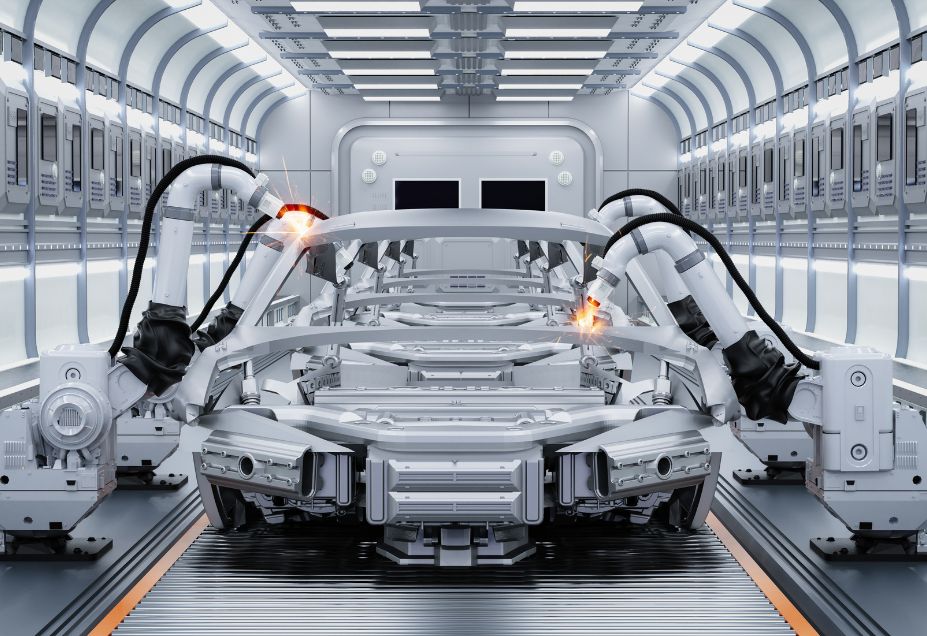The automotive industry has long been at the forefront of technological innovation, with each passing decade witnessing remarkable advancements in vehicle design, safety features, and performance.
In recent years, one of the most transformative forces driving change within this sector is Artificial Intelligence (AI). AI, often considered the pinnacle of human ingenuity, has infiltrated nearly every aspect of our lives, and the automotive industry is no exception.
From autonomous vehicles and predictive maintenance to enhanced driver assistance systems and personalized user experiences, AI has reshaped the landscape of the automotive world.
In this comprehensive article, we will delve into the multifaceted role of AI in the automotive industry, exploring its various applications, benefits, challenges, and the future it promises.
Introduction to AI in the Automotive Industry
What is AI?
Before we delve into the impact of AI on the automotive sector, let’s establish a fundamental understanding of AI. Generally speaking, artificial intelligence refers to the development of machines that can perform functions requiring the intelligence of a human being.
These tasks encompass a broad spectrum, including problem-solving, decision-making, speech recognition, language translation, and pattern recognition.
The Automotive Industry and Its Evolution
The automotive industry, dating back to the late 19th century, has witnessed remarkable transformations throughout its history.
It has evolved from simple, manually operated vehicles to complex, highly automated machines that incorporate cutting-edge technology. The integration of AI into this industry represents the latest and most significant wave of change.

The Applications of AI in the Automotive Industry
AI’s influence in the automotive industry is far-reaching, touching nearly every aspect of vehicle design, manufacturing, operation, and ownership. Here, we explore the various applications of AI within this sector:
1. Autonomous Vehicles
The development of autonomous or self-driving vehicles is one of the most high-profile applications of AI in the automotive industry.
AI algorithms, powered by a combination of sensors, cameras, radar, and Lidar technology, provide vehicles with the ability to perceive the environment, make decisions, and navigate safely without the assistance of human operators.
a. Levels of Autonomy
Autonomous vehicles are categorized into several levels of automation, ranging from Level 0 (no automation) to Level 5 (full automation). Each level represents a different degree of AI integration and human involvement.
b. Benefits of Autonomous Vehicles
- Safety: AI-driven autonomous vehicles have the potential to reduce accidents caused by human error, which is a significant cause of road fatalities.
- Efficiency: Self-driving cars can optimize traffic flow, reduce congestion, and improve fuel efficiency.
- Accessibility: Autonomous vehicles can provide mobility solutions for individuals who are unable to drive due to disabilities or age.
2. Advanced Driver Assistance Systems (ADAS)
ADAS consists of a number of AI-driven technologies and features designed to improve the safety and comfort of the driver. These systems often serve as stepping stones towards fully autonomous vehicles.
a. Key Features of ADAS
- Lane-keeping assistance: AI algorithms help vehicles stay within their designated lanes.
- Adaptive cruise control: AI adjusts vehicle speed based on the traffic flow.
- Collision avoidance: AI detects potential collisions and takes preventive actions.
b. Impact of ADAS
- Safety Improvement: ADAS features have been instrumental in reducing accidents and enhancing road safety.
- User Experience: Enhanced driver comfort and reduced fatigue during long journeys.
3. Predictive Maintenance
AI plays a pivotal role in predictive maintenance, which involves using data and AI algorithms to predict when a vehicle’s components are likely to fail. This approach helps prevent breakdowns and reduces maintenance costs.
a. How Predictive Maintenance Works
- Data Collection: Sensors collect data on various vehicle components.
- Data Analysis: AI algorithms analyze the data to detect patterns and anomalies.
- Maintenance Alerts: When a potential issue is detected, the system alerts the owner or service provider.
b. Benefits of Predictive Maintenance
- Cost Reduction: Preventing breakdowns and addressing issues proactively reduces maintenance expenses.
- Vehicle Longevity: Predictive maintenance extends the lifespan of vehicles.
- Minimized Downtime: Vehicles spend less time in the repair shop, minimizing disruption for owners.
4. Personalized User Experiences
AI can create personalized user experiences by analyzing user data and preferences. From in-car entertainment to climate control and navigation, AI tailors the vehicle’s environment to individual preferences.
a. Virtual Assistants
- Voice Recognition: AI-powered virtual assistants understand and respond to voice commands.
- Personalized Recommendations: AI suggests music, destinations, and other preferences based on user history.
b. In-Car Entertainment
- Content Recommendation: AI recommends movies, music, and podcasts.
- Adaptive Lighting and Seating: AI adjusts the vehicle’s interior for maximum comfort.
5. Supply Chain Optimization
AI optimizes the automotive supply chain by predicting demand, automating inventory management, and streamlining production processes.
a. Demand Forecasting
- Data Analysis: AI analyzes historical sales data and market trends.
- Inventory Management: Automating orders based on predictions prevents overstocking or shortages.
b. Production Optimization
- Quality Control: AI ensures product quality through real-time monitoring.
- Robotic Manufacturing: AI-driven robots assist in assembling vehicles with precision and efficiency.
6. Customization and Design
AI assists in vehicle customization and design by generating design ideas, simulating crash tests, and optimizing aerodynamics.
a. Generative Design
- AI-Generated Designs: AI generates design options based on specified criteria.
- Cost and Material Optimization: AI minimizes production costs while maintaining safety standards.
7. Traffic Management
AI-based traffic management systems improve traffic flow, reduce congestion, and enhance overall urban mobility.
a. Intelligent Traffic Lights
- Dynamic Timing: Traffic lights adjust their timings based on real-time traffic data.
- Reduced Congestion: Smoother traffic flow leads to reduced congestion and shorter travel times.
b. Predictive Traffic Analytics
- Accident Prediction: AI predicts accidents and reroutes traffic accordingly.
- Optimal Routing: AI provides drivers with the fastest routes based on current conditions.
Benefits of AI in the Automotive Industry
The integration of AI into the automotive industry brings forth numerous advantages that extend beyond the vehicles themselves. Here are some of the key benefits:
1. Safety Improvement
- Reduced Accidents: AI-driven autonomous vehicles and ADAS features reduce accidents caused by human error.
- Emergency Response: AI can instantly detect accidents and notify emergency services.
2. Environmental Impact
- Reduced Emissions: AI-optimized traffic flow and electric vehicle (EV) adoption help reduce greenhouse gas emissions.
- Energy Efficiency: AI enhances vehicle fuel efficiency and battery management in EVs.
3. Enhanced User Experience
- Personalization: AI tailors in-car experiences to individual preferences.
- Convenience: Predictive maintenance and AI-based diagnostics minimize inconvenience due to breakdowns.
4. Cost Reduction
- Maintenance Costs: Predictive maintenance reduces maintenance expenses.
- Fuel Efficiency: AI optimizes fuel consumption and reduces fuel costs.
5. Improved Efficiency
- Traffic Flow: AI-based traffic management systems optimize traffic flow, reducing congestion and travel times.
- Supply Chain: AI streamlines supply chain operations, minimizing delays and optimizing inventory.
Challenges and Ethical Considerations
While AI offers numerous benefits to the automotive industry, it also presents several challenges and ethical considerations that need to be addressed:
1. Safety and Reliability
- AI Failures: Ensuring the safety and reliability of AI systems is paramount, especially in autonomous vehicles.
- Cybersecurity: Protecting AI systems from hacking and cyberattacks is a significant concern.
2. Data Privacy
- User Data: Collecting and analyzing user data for personalization raises privacy concerns.
- Data Security: Safeguarding user data against breaches and misuse is essential.
3. Job Displacement
- Automation Impact: The automation of manufacturing processes may lead to job displacement for human workers.
- Reskilling: Addressing the need for reskilling and job transition programs is crucial.
4. Ethical Decision-Making
- Autonomous Vehicles: Programming AI to make ethical decisions during accidents is a complex challenge.
- Bias and Fairness: Ensuring AI systems are free from biases and make fair decisions is essential.
The Future of AI in the Automotive Industry
The role of AI in the automotive industry is poised to expand further in the coming years. Several trends and developments are on the horizon:
1. Full Autonomy
- Level 5 Autonomy: Achieving full autonomy (Level 5) remains the ultimate goal for the industry.
- Regulatory Challenges: Developing regulations and standards for autonomous vehicles is an ongoing process.
2. AI-Driven Ecosystems
- Connected Vehicles: AI will facilitate communication between vehicles and infrastructure, improving traffic management.
- Smart Cities: AI will play a pivotal role in the development of smart cities and transportation systems.
3. Sustainability
- Electric and Hybrid Vehicles: AI will continue to enhance the performance and efficiency of electric and hybrid vehicles.
- Eco-Friendly Manufacturing: AI-driven manufacturing processes will focus on reducing environmental impact.
4. Enhanced User Experiences
- Augmented Reality: AI-powered augmented reality interfaces will provide intuitive in-car experiences.
- Health and Wellbeing: AI may monitor driver health and provide alerts for fatigue or health issues.
Conclusion
The integration of AI into the automotive industry is a transformative force that promises to reshape the way we think about mobility. From autonomous vehicles and enhanced safety features to personalized user experiences and environmental sustainability, AI is driving progress on multiple fronts.
However, it is essential to navigate the challenges and ethical considerations that come with this technological revolution.
With responsible development, rigorous safety standards, and a commitment to data privacy, the automotive industry can fully harness the potential of AI to create a safer, more efficient, and environmentally friendly future of mobility.
As we look ahead, the automotive industry’s journey with AI continues to accelerate, opening new horizons for innovation and redefining our relationship with the vehicles we drive.

Recent Comments